Physical Address
304 North Cardinal St.
Dorchester Center, MA 02124
Stenosis of the renal artery, which is usually focal, can cause a cascade of ischaemic-driven events in the kidney, in addition to other potential insults such as cholesterol embolisation. This can lead to clinical consequences such as secondary hypertension, impaired renal function and fluid retention (flash pulmonary oedema). Much interest has focused on correcting the anatomical abnormality, initially with angioplasty and more recently with stents, in an attempt to reverse or halt the clinical manifestations.
In Western populations, atherosclerosis is the leading cause in over 90% of cases. However, in a younger age group, the non-atheromatous arteritides should be considered ( Table 84.1 ), particularly in non-Caucasians.
|
Once renal artery stenosis (RAS) is suspected clinically, the optimal imaging technique for assessment of the renal arteries is contrast-enhanced magnetic resonance angiography (MRA) ( Fig. 84.1 ). However, due to a small number of reported cases of nephrogenic systemic fibrosis linked to gadolinium contrast media exposure, recent guidelines suggest caution using contrast media if the estimated glomerular filtration rate (eGFR) is less than 30 mL/min and gadolinium contrast medium is contraindicated when the eGFR is less than 15 mL/min. Other imaging options include computed tomographic angiography (CTA) and newer magnetic resonance imaging (MRI) sequences, avoiding contrast media altogether. Doppler ultrasound (US) and functional nuclear medicine scans are less commonly used, although they may still play a limited role in specific circumstances.
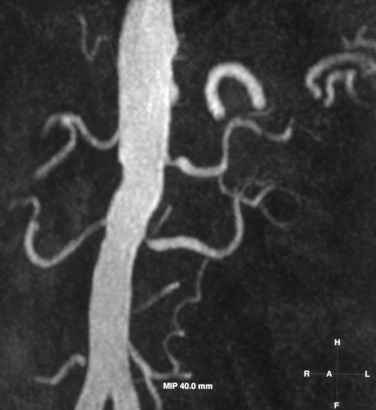
Atheromatous renovascular disease (ARVD) is by far the commonest cause of RAS and usually develops as part of a systemic inflammatory atheromatous syndrome with disease in other vascular beds (coronary, peripheral). There is a strong correlation with smoking and type 2 diabetes. Anatomically, more than 90% of ARVD involves the renal artery ostium as a result of encroachment of aortic atheromatous plaques.
Many patients are asymptomatic, and the condition is often detected whilst investigating other symptoms (e.g. lower limb ischaemia). Other patients present with hypertension, impaired renal function or ‘flash pulmonary oedema’. The latter is a poorly understood condition where there are recurrent attacks of fluid overload with normal or near-normal cardiac function but the kidney's ability to excrete fluid is impaired.
Treatment of the global atherosclerotic burden should be addressed with smoking cessation, aspirin, statins and optimisation of blood pressure control by medical therapy. There is limited evidence that this ‘package of medical treatment’ can stabilise atheromatous plaque and may even induce regression.
The approach to revascularisation of the stenotic artery has evolved over the years. Initially performed by open surgical repair, percutaneous transluminal angioplasty (PTA) gained rapid acceptance in the 1980s. However, high restenosis rates due to elastic recoil from the aortic plaques led to disappointing anatomical and clinical results. The introduction of metallic stents in the early 1990s led to a resurgence in endovascular activity and the mechanical limitations of renal PTA were overcome with a significant reduction in restenosis. Almost overnight, renal stenting became the dominant strategy for ARVD.
However, although stenting clearly led to improved patency, it was often difficult to clearly link this with clinical benefit: that is, blood pressure reduction or improvement in renal function. It was often said that the ‘rule of thirds’ applied with one-third showing some improvement, another third static and the final third deteriorating. This continuing uncertainty triggered several randomised trials which spanned both the PTA and stenting eras.
The early trials predated stents and focused on blood pressure outcomes. The later trials used stents exclusively and focused on renal function. Most of these trials were small and underpowered. Subsequent meta-analyses failed to show any clear benefit for revascularisation but suggested larger studies to ensure a clinically important difference was not being missed. The two largest and most recent trials, angioplasty and stenting for renal artery lesions (ASTRAL) ( n = 806) and cardiovascular outcomes in renal atherosclerotic lesions (CORAL) ( n = 947), failed to show any benefit from renal stenting with respect to clinical events, including blood pressure, renal function, cardiovascular events and death.
As a result of the lack of supportive trial data, routine renal artery stenting for hypertension or impaired renal function is difficult to justify. However, not all patients were entered into these trials, and possible but unproven indications for renal stenting may include the following:
Intractable hypertension on maximum medical treatment.
Rapidly deteriorating renal function.
A single kidney with a critical stenosis (>90%).
Flash pulmonary oedema.
Acute renal failure with preserved renal size (>8 cm).
Careful individualised patient evaluation is necessary when considering intervention because complications can occur in 5% to 10% of procedures. These are mostly minor (e.g. groin haematoma) but can include damage to the renal artery, cholesterol embolisation and occasional loss of the kidney. Very rarely, a patient may present with acute renal failure and acute occlusion of a single renal artery. Renal artery stenting in these circumstances may be worthwhile and can restore renal function with little to lose ( Fig. 84.2 ).
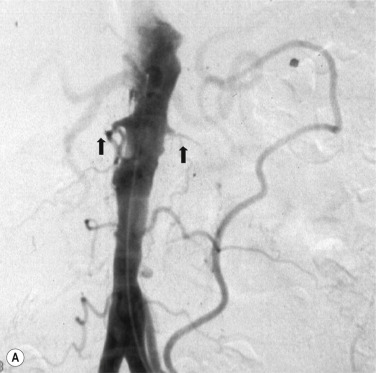
The angle from which the renal artery leaves the aorta will help to decide between a femoral and an arm (brachial or radial) approach . Over 90% are approachable from the femoral artery. Similarly, the angle at which the renal artery ostium lies in the coronal plane will determine the correct angle to place the ‘C-arm’, in order to project the origin of the renal artery clear of the aorta. Careful perusal of the baseline imaging is essential. Advances in guidewire and catheter technology have resulted in most operators currently using so-called low-platform systems, which use a 3–4F catheter with 0.014–0.018 guidewires. Delivered through a 6–7F guiding catheter, they are less traumatic than the old 0.035 guidewire systems. Having accessed the renal artery ostium and placed a guide catheter, the lesion is traversed and angioplastied with an appropriately sized balloon. Intraoperative heparin and a proprietary antispasmodic agent should be administered. When dealing with non-atheromatous lesions, angioplasty is usually sufficient ( Fig. 84.3 ), but atheromatous lesions are almost always stented to overcome elastic recoil.
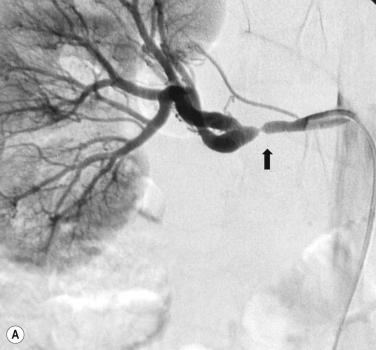
The procedure is similar to PTA and again uses a ‘low-profile’ stent system. The lesion is crossed as aforementioned, and the stenosis is predilated to 3 mm, followed by placement of the stent. Accurate C-arm positioning is critical to ensure accurate stent placement with 2–3 mm protruding out into the aorta. Most operators use balloon-expandable rather than self-expanding stents because they are easier to place accurately at the renal artery ostium ( Fig. 84.4 ).
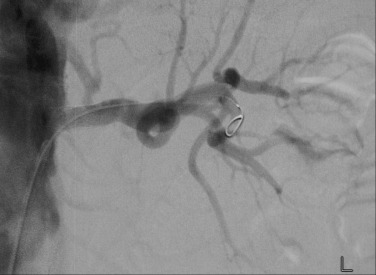
In the West, fibromuscular disease accounts for 10% of all cases of RAS. Although it is most frequently found in the renal arteries (60%), other major vessels such as the carotid, visceral and coronary arteries can be involved. There are at least five different pathological types of fibromuscular disease, but the most common is medial fibroplasia where there are alternating areas of stenosis and aneurysmal dilation leading to the classical ‘string of beads’ appearance ( Fig. 84.5 ). A much rarer type leads predominantly to aneurysm formation ( Fig. 84.6 ) and requires a different management strategy. The typical presentation is in a young person, commonly female, with new-onset hypertension. Renal function is usually normal, and, although the lesion may progress, complete vessel occlusion is rare. Although initial management with drugs is usual, there is a strong case for angioplasty as the lesions respond well and there is often a good chance of ‘cure’ or significant improvement in blood pressure control.
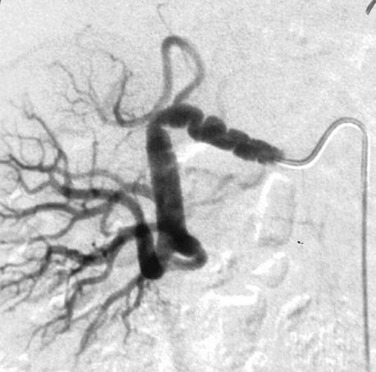
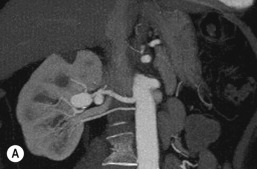
The epidemiology of RAS is different in the Indian subcontinent and the Far East, with vasculitis, including Takayasu arteritis, said to be responsible for up to 60% of RAS cases. Although PTA can be used, this inflammatory condition can be resistant to dilation. Steroids are often used successfully to suppress the inflammatory component.
This rare congenital condition is known to cause a myriad of symptoms and signs. Less well recognised is the involvement of vessels, commonly the renal arteries. The pathology is usually one of stenosis and aneurysmal dilatation. Although PTA can be used, the lesions are often resistant to dilatation, and in this young patient group, surgical reconstruction of the vessel may be a better option.
This rare congenital condition presents in childhood. Although the renal arteries are commonly involved there is almost always aortic hypoplasia and the extent to which angioplasty and stenting can help is very limited.
Endovascular approach has all but replaced open surgery.
Non-atheromatous disease responds well to percutaneous transluminal angioplasty (PTA) alone.
Stents perform better than PTA for atheromatous disease.
Evidence base for atheromatous disease is poor.
Become a Clinical Tree membership for Full access and enjoy Unlimited articles
If you are a member. Log in here